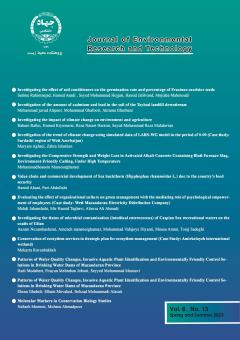Investigation of compressive strength and weight loss in high-temperature alkaline concrete
Subject Areas : environmental economy
Mohammadhosseim Mansourghanaei
1
*
![]()
1 - Ph.D Student in Civil Engineering, Department of Civil Engineering, Chalous Branch, Islamic Azad University, Chalous, Iran
Keywords: Ordinary concrete, Alkaline concrete, Compressive strength, Weight loss, Scanning electron microscope.,
Abstract :
Environmental protection plays an effective role in human health. In this regard, in recent decades, high-strength concrete in order to excel mechanical properties and durability and eliminate environmental disadvantages (due to the production of toxic carbon dioxide) in ordinary concrete, has been considered by civil engineering researchers. In this laboratory study, a mixing plan was made of ordinary concrete containing Portland cement with a grade of 500 kg/m3 and a mixing plan was made of alkaline concrete based on slag from a composing furnace. In order to evaluate the mechanical properties and durability, compressive strength and weight reduction tests of concrete were performed at 21 and 600 °C at a 90-day curing age in concrete. Applying high heat in concrete samples caused a decrease in the results of compressive strength test in ordinary concrete and reinforced concrete by 42.31% and 14.9%, respectively, and in weight loss test by 0.0067 and 0.0064%, respectively. Weight loss was achieved in ordinary concrete and alkaline concrete. Alkaline reinforced concrete in the compressive strength test at 21 and 600 degrees Celsius, showed an advantage of 11.41 and 64.35 percent compared to ordinary concrete. The results of scanning electron microscopy imaging test were in coordination with the results of other tests in this study.
Nosrati, A., Zandi, Y., Shariati, M., Khademi, K., Aliabad, M., Marto, A., & Khorami, M. (2018). Portland cement structure and its major oxides and fineness. Smart structures and systems, 22(2), 425-432
Siddique, R., & Kaur, D. (2012). Properties of concrete containing ground granulated blast furnace slag (GGBFS) at elevated temperatures. Journal of Advanced Research, 3(1), 45-51.
Yüksel, İ., Siddique, R., & Özkan, Ö. (2011). Influence of high temperature on the properties of concretes made with industrial by-products as fine aggregate replacement. Construction and building materials, 25(2), 967-972.
Huseien, G. F., Mirza, J., Ismail, M., Ghoshal, S. K., & Ariffin, M. A. M. (2018). Effect of metakaolin replaced granulated blast furnace slag on fresh and early strength properties of geopolymer mortar. Ain Shams Engineering Journal, 9(4), 1557-
1566. Allahverdi, A. L. I., Kani, E. N., & Yazdanipour, M. (2011). Effects of blast-furnace slag on natural pozzolan-based geopolymer cement. Ceramics-Silikáty, 55(1), 68-78.
Nuaklong, P., Sata, V., & Chindaprasirt, P. (2016). Influence of recycled aggregate on fly ash geopolymer concrete properties. Journal of Cleaner Production, 112, 2300-2307.
Singh, B., Ishwarya, G., Gupta, M., & Bhattacharyya, S. K. (2015). Geopolymer concrete: A review of some recent developments. Construction and building materials, 85, 78-90.
Zhuang, X. Y., Chen, L., Komarneni, S., Zhou, C. H., Tong, D. S., Yang, H. M., ... & Wang, H. (2016). Fly ash-based geopolymer: clean production, properties and applications. Journal of Cleaner Production, 125, 253-267.
Yunsheng, Z., Wei, S., & Zongjin, L. (2010). Composition design and microstructural characterization of calcined kaolin-based geopolymer cement. Applied Clay Science, 47(3-4), 271-275.
Davidovits, J. (2008). Geopolymer chemistry and applications. Geopolymer Institute.
Neupane, K., Chalmers, D., & Kidd, P. (2018). High-strength geopolymer concrete—properties, advantages and challenges. Advances in Materials, 7(2), 15-25.
Vora, P. R., & Dave, U. V. (2013). Parametric studies on compressive strength of geopolymer concrete. Procedia Engineering, 51, 210-219.
McNulty, E. (2009). Geopolymers: an environmental alternative to carbon dioxide producing ordinary Portland cement. Department of Chemistry, The Catholic University of America.
Bakharev, T. (2006). Thermal behaviour of geopolymers prepared using class F fly ash and elevated temperature curing. Cement and concrete Research, 36(6), 1134-1147.
Mane, S., & Jadhav, H. S. (2012). Investigation of geopolymer mortar and concrete under high temperature. Magnesium, 1(5).
Comrie, D. C., & Kriven, W. M. (2004). Composite cold ceramic geopolymer in a refractory application. In Advances in Ceramic Matrix Composites IX, Proceedings (pp. 211-225).
Bakhtiyari, S., Allahverdi, A., Rais-Ghasemi, M., Zarrabi, B. A., & Parhizkar, T. (2011). Self-compacting concrete containing different powders at elevated temperatures–Mechanical properties and changes in the phase composition of the paste.
Thermochimica acta, 514(1-2), 74-81. Pilehvar, S., DuyCao, V., M.Szczotok, A., Carmona, M., Valentini, L., Lanzón, M., LenaKjøniksen, A. (2018). Physical and mechanical properties of fly ash and slag geopolymer concrete containing different types of micro-encapsulated phase change materials. Construction and Building Materials, 173, 28-39.
Deb, P., Nath, P., & Sarker, P. (2015). Drying shrinkage of slag blended fly ash geopolymer concrete cured at room temperature. Procedia Engineering, 125, 594-600.
Mehta, P. K., & Monteiro, P. J. (2017). Concrete microstructure, properties and materials.
Kong, D. L., & Sanjayan, J. G. (2010). Effect of elevated temperatures on geopolymer paste, mortar and concrete. Cement and concrete research, 40(2), 334-339.
Hongjian, D., Suhuan , D., & Liu, X. (2014). Durability performances of concrete with nano-silica. Construction and building materials, 73, 705-712.
Ren, W., Xu, J., & Bai, E. (2016). Strength and ultrasonic characteristics of alkali-activated fly ash-slag geopolymer concrete after exposure to elevated temperatures. Journal of Materials in Civil Engineering, 28(2), 04015124.
Amiri, M., & Aryanpoor, M. (2019). The Effects of High Temperatures on Concrete Performance based on Nanostructural Changes in Calcium Silicate Hydrate (CSH). Concrete Research, 12(4), 69-80.
Provis, J. L., & Van Deventer, J. S. (2009). Introduction to geopolymers. In Geopolymers (pp. 1-11). Woodhead Publishing.
Brindley, G. W. (1975). Thermal transformations of clays and layer silicates. In Proceedings of the international clay conference (pp. 119-129). Applied Publishers Wilmette, IL.

